

🌿 What is Madecassoside?
Madecassoside is a triterpenoid compound and one of the principal bioactive components isolated from Centella Asiatica (CICA). It is renowned for its anti-inflammatory, antioxidant, and wound-healing properties.
It is 1)A purified molecule (not a crude extract), 2)Water-soluble and skin-compatible, 3)Well-tolerated, even for highly sensitive skin.
Madecassoside is often used as a refined, high-purity version of CICA, making it suitable for medical-grade and post-procedure skincare.
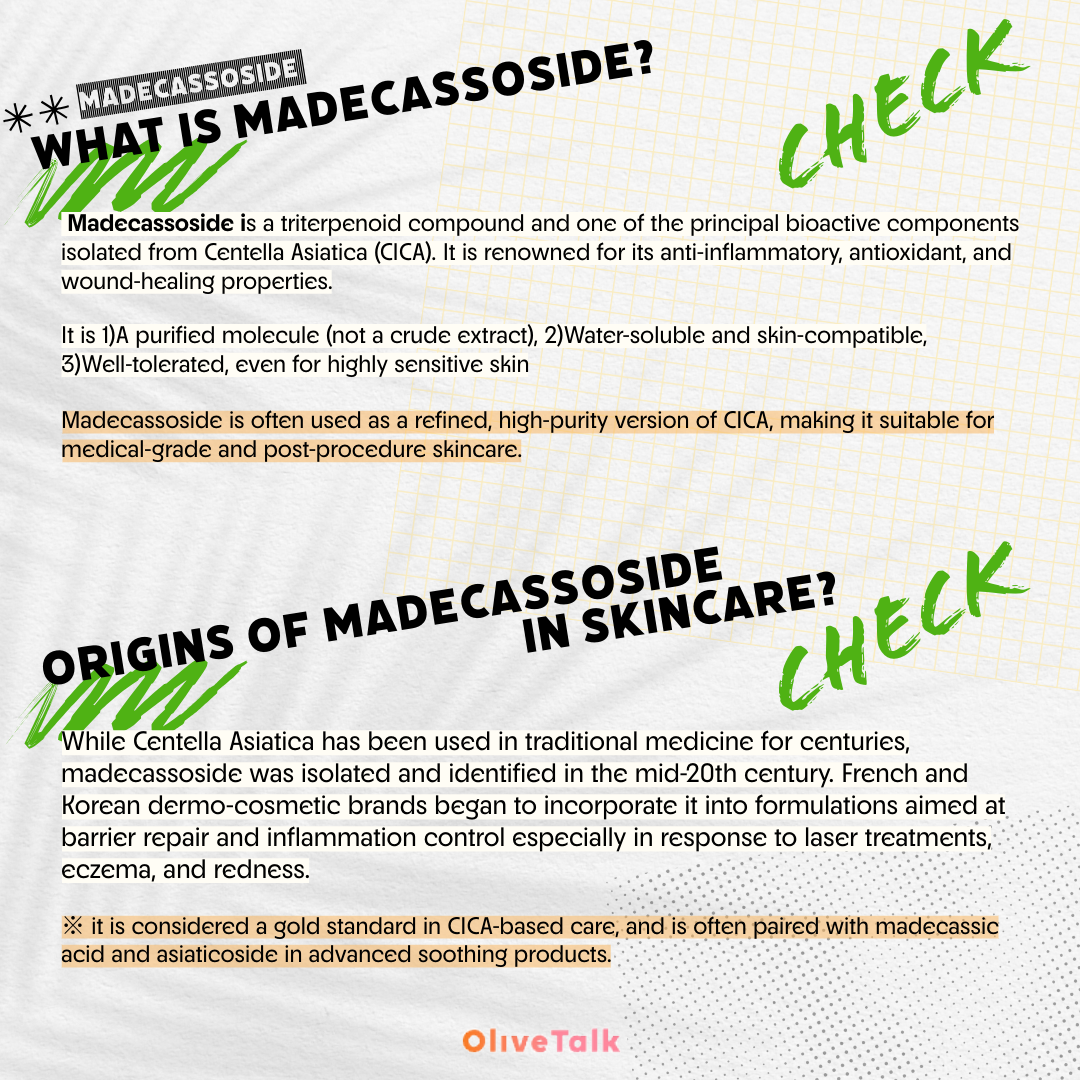
🌱 Origins of Madecassoside in Skincare
While Centella Asiatica has been used in traditional medicine for centuries, madecassoside was isolated and identified in the mid-20th century. French and Korean dermo-cosmetic brands began to incorporate it into formulations aimed at barrier repair and inflammation control especially in response to laser treatments, eczema, and redness.
Now, it is considered a gold standard in CICA-based care, and is often paired with madecassic acid and asiaticoside in advanced soothing products.
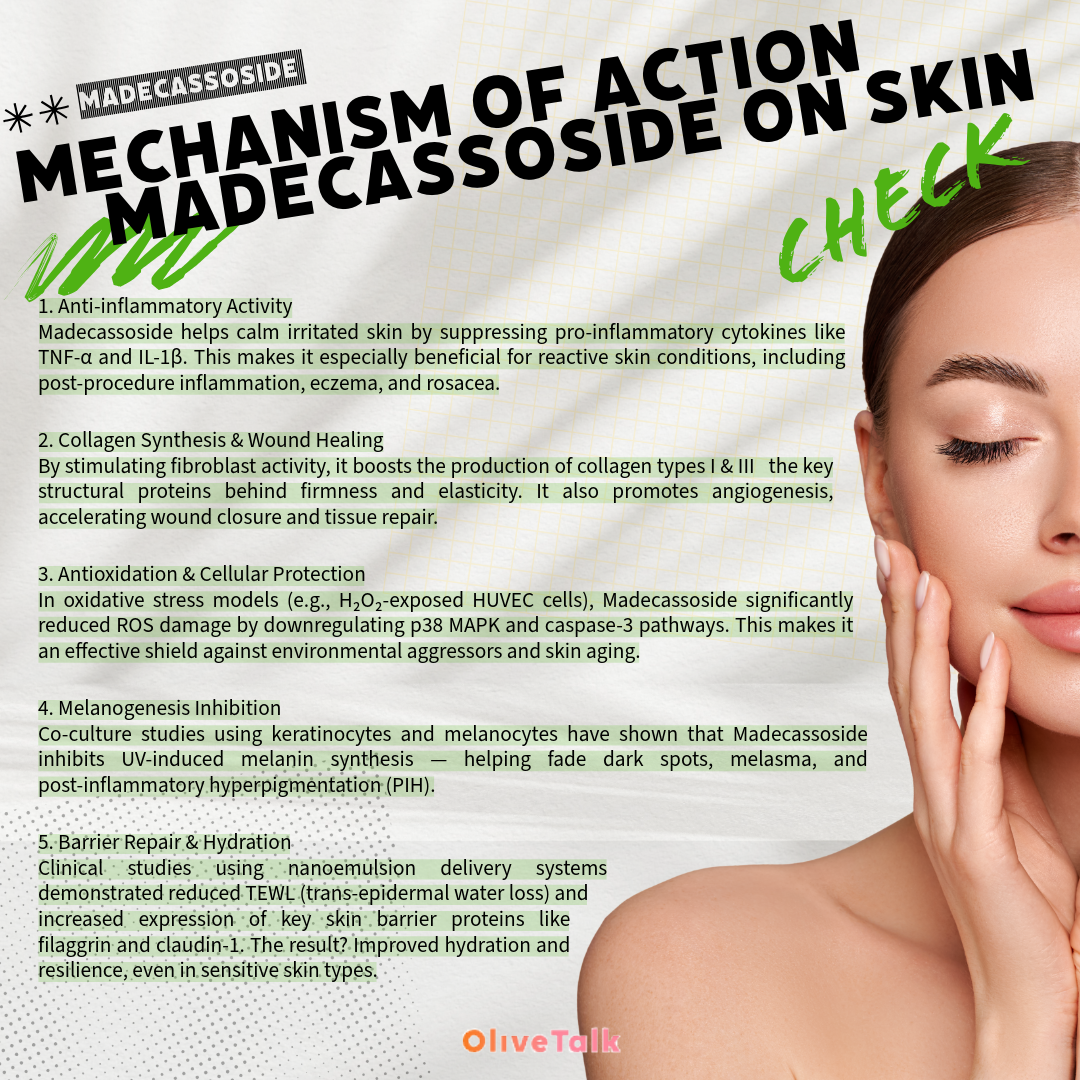
🔬 Mechanism of Action I (Anti-Inflammatory Repair)
Madecassoside exerts its skin-calming effects
1) Inhibiting pro-inflammatory cytokines (e.g., TNF-α, IL-1β)
2) Promoting collagen synthesis via fibroblast activation
3) Strengthening the skin’s natural lipid barrier
4) Enhancing recovery from irritation, eczema, and redness
💡 Mechanism of Action II (Skin Benefits)
1) Rapid reduction in redness and irritation
2) Accelerated wound and scar healing
3) Barrier restoration after chemical peels, laser, or retinoid use
4) Antioxidant protection against environmental stress
5) Increased hydration and reduced transepidermal water loss (TEWL)
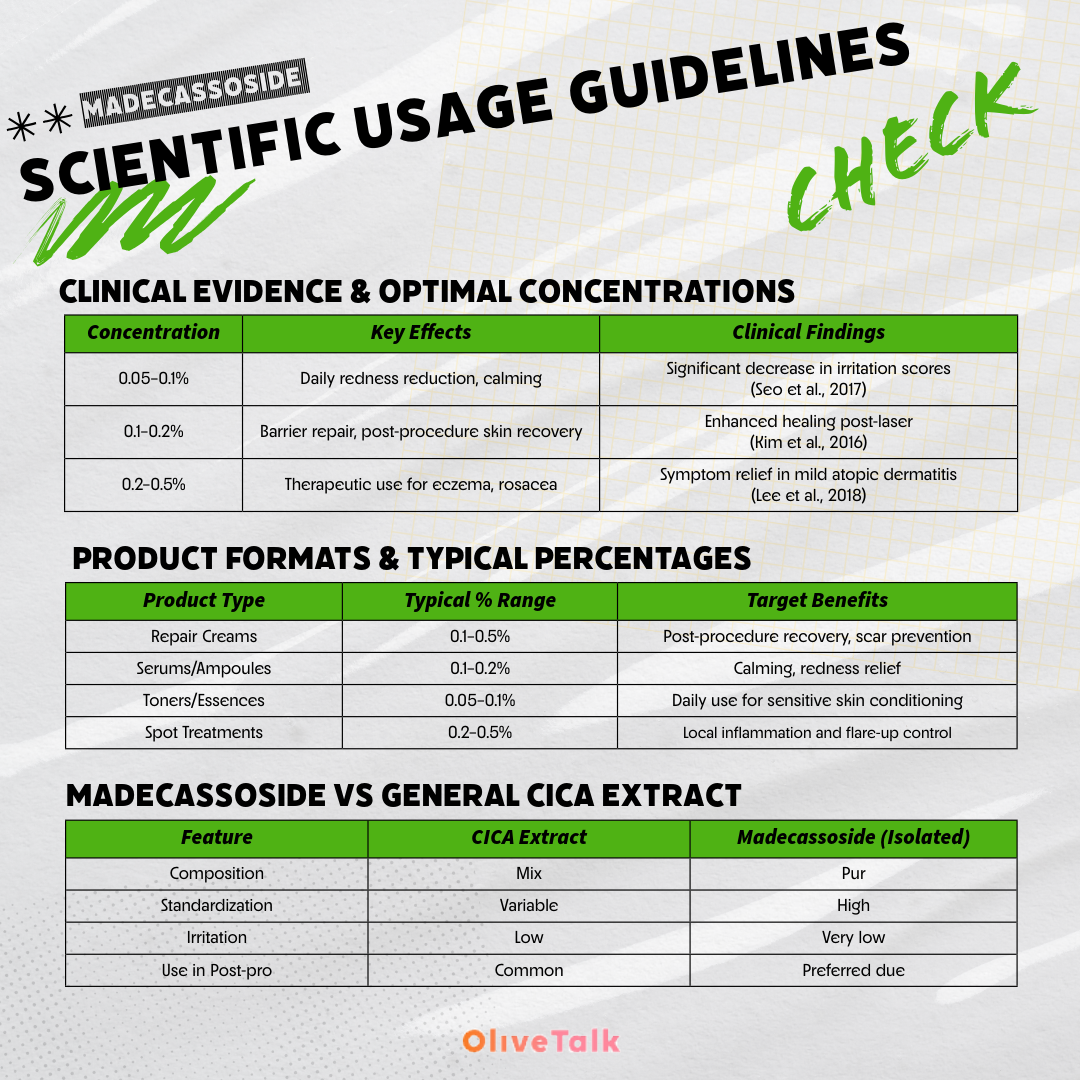
🧪 Clinical Evidence & Optimal Concentrations
(Concentration / Key Effects / Clinical Findings)
- 0.05–0.1% / Daily redness reduction, calming / Significant decrease in irritation scores (Seo et al., 2017)
- 0.1–0.2% / Barrier repair, post-procedure skin recovery / Enhanced healing post-laser (Kim et al., 2016)
- 0.2–0.5% / Therapeutic use for eczema, rosacea / Symptom relief in mild atopic dermatitis (Lee et al., 2018)
🧴 Product Formats & Typical Percentages
(Product Type / Typical % Range / Target Benefits)
- Repair Creams / 0.1–0.5% / Post-procedure recovery, scar prevention
- Serums/Ampoules / 0.1–0.2% / Calming, redness relief
- Toners/Essences / 0.05–0.1% / Daily use for sensitive skin conditioning
- Spot Treatments / 0.2–0.5% / Local inflammation and flare-up control
🔍 Madecassoside vs. General CICA Extract
(Feature / CICA Extract / Madecassoside (Isolated))
- Composition / Mix / Pur
- Standardization / Variable / high
- Irritation / Low / Very low (hypo
- Use in Post-pro / Common / Preferred due
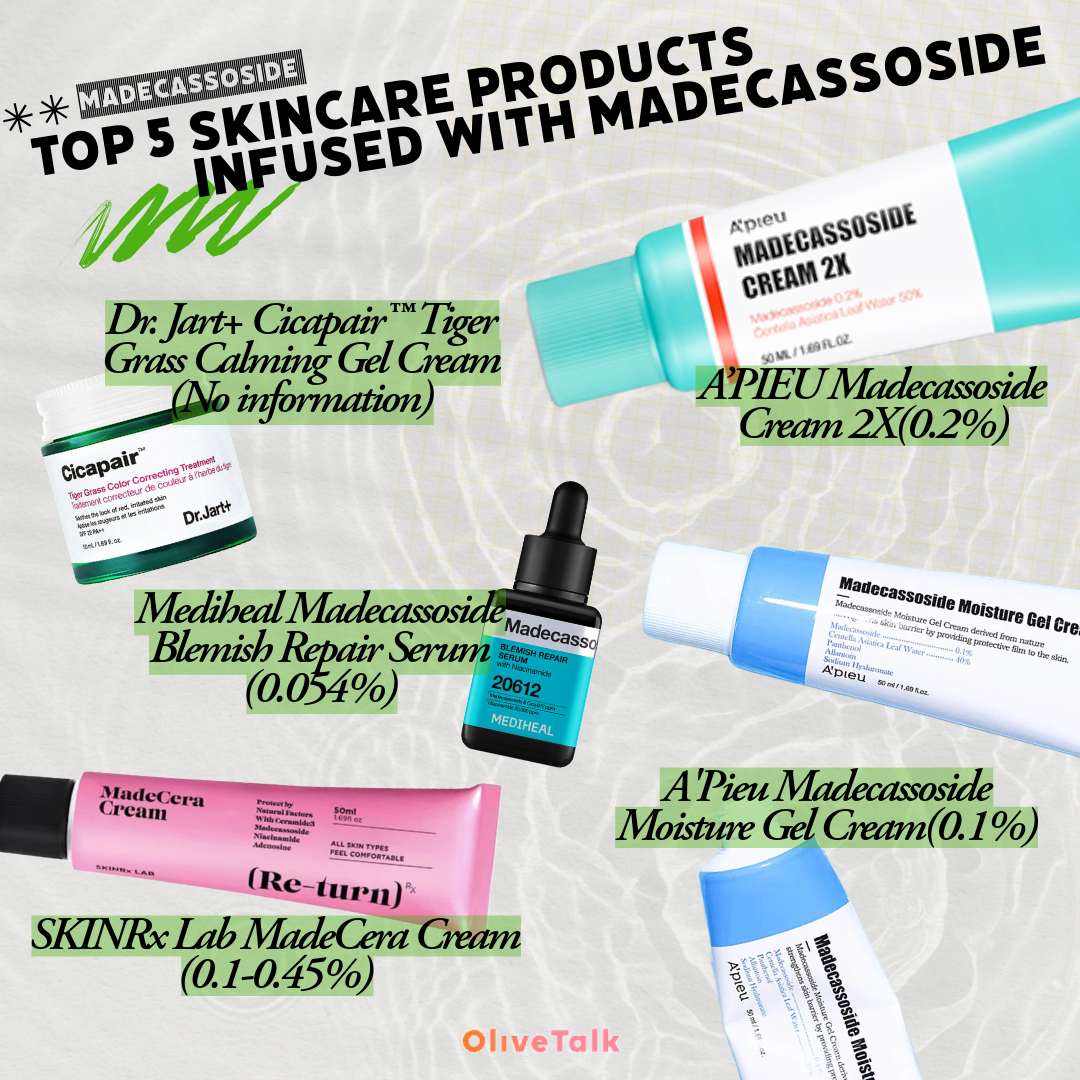
<Top 5 Skincare Products Infused with Madecassosid)>
1. A’PIEU Madecassoside Moisture Gel Cream
Content : 0.1%
Country : KR
2. A’PIEU Madecassoside Cream 2X
Content : 0.2%
Country : JP
3. SKINRx Lab MadeCera Cream
Content : 0.1–0.45%
Country : KR
4. Mediheal Madecassoside Blemish Repair Serum
Content : 0.054%
Country : KR
5. Dr. Jart+ Cicapair™ Tiger Grass Calming Gel Cream
Content : No information
Country : KR
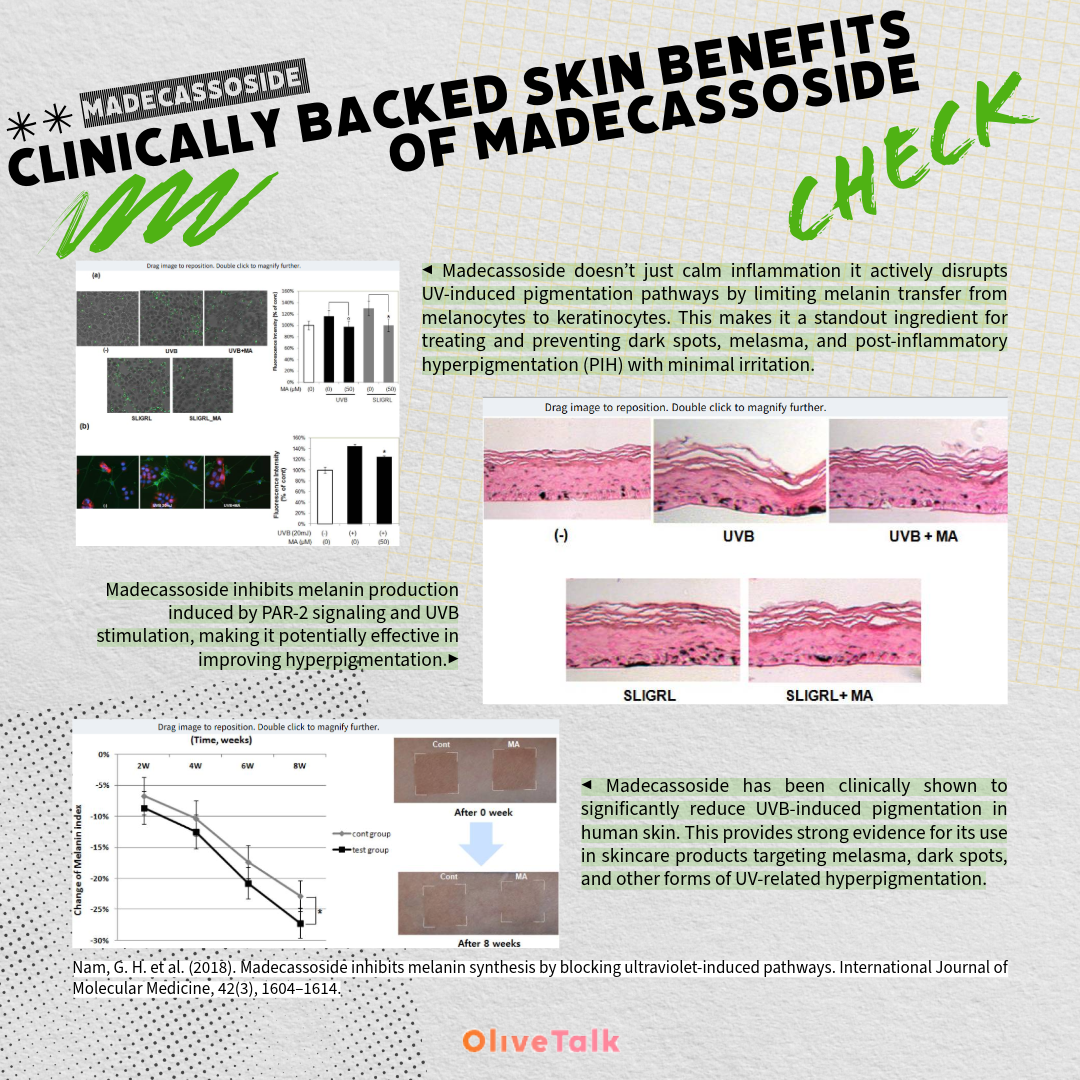
🏛️ Historical Note : From Herbal Extract to Clinical Molecule
Madecassoside is a testament to modern skincare’s move toward purified actives. Extracted from the legendary tiger herb (Centella Asiatica), it offers the soothing power of traditional medicine with the predictability and purity of pharmaceutical science.
💾 Final Thoughts from a Skincare Expert
Madecassoside is a low-risk, high-benefit ingredient ideal for red, sensitive, and healing skin. Whether you’re recovering from a breakout or a clinic treatment, madecassoside delivers proven results with unmatched gentleness.
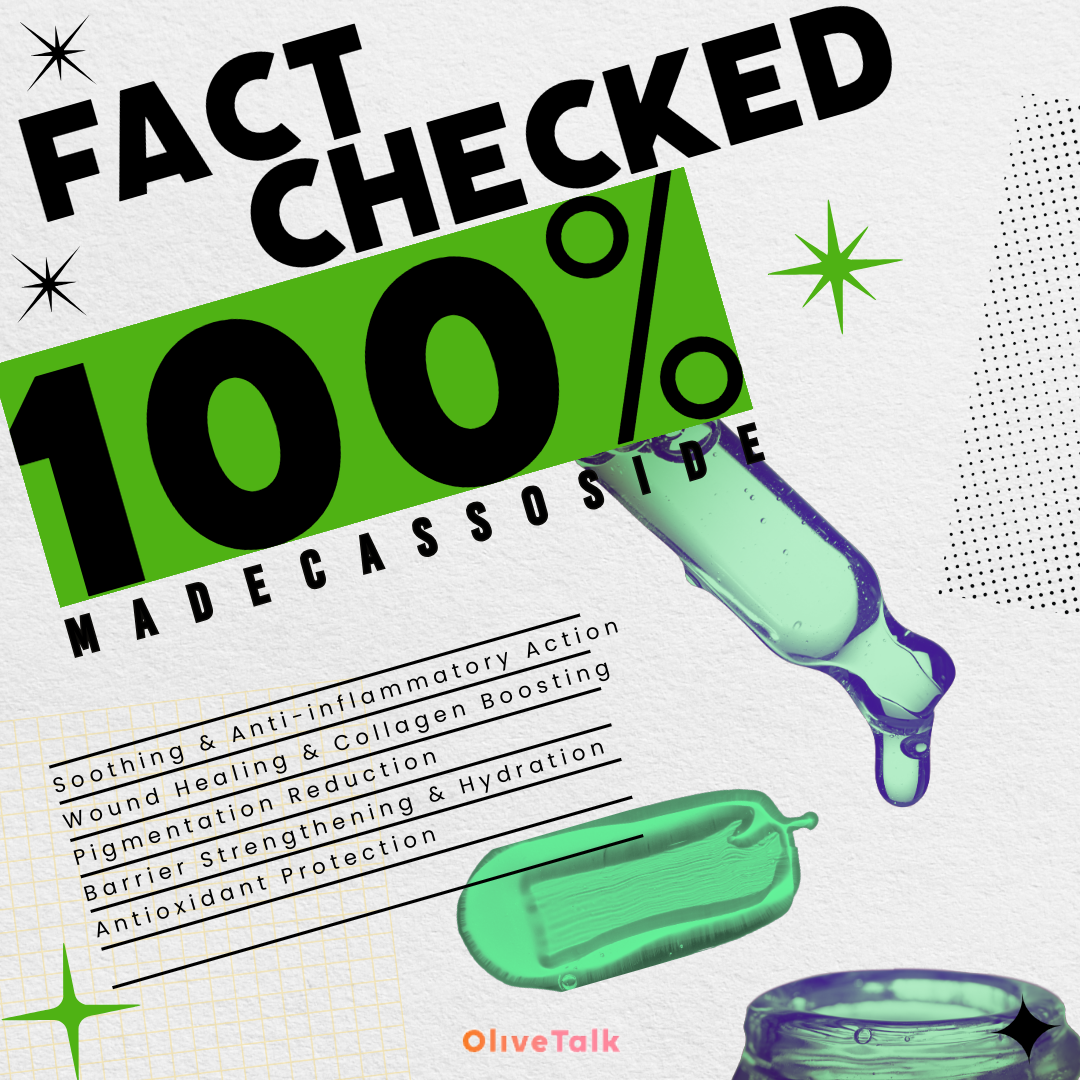
📚 References
1. Seo, K. Y. et al. (2017). The calming effect of madecassoside in sensitive skin: A randomized clinical study. Journal of Dermatological Science, 87(3), 250–256.
2. Kim, H. Y. et al. (2016). Madecassoside accelerates recovery post-laser in clinical and in vitro models. Laser Therapy, 25(4), 223–229.
3. Lee, M. J. et al. (2018). Therapeutic role of madecassoside in atopic dermatitis: A pilot study. Annals of Dermatology, 30(1), 45–52.
4. Chen, X. et al. (2020). Molecular effects of madecassoside on collagen and inflammatory pathways. Skin Pharmacology and Physiology, 33(2), 89–97.
 10Comments
10Comments-
 Influencer5 days agoOkkkkk so that's why I really loved Mediheal Madecassoside blemish repair serum 🤣 I used it even without knowing bout it lol ty for sharing girllll
Influencer5 days agoOkkkkk so that's why I really loved Mediheal Madecassoside blemish repair serum 🤣 I used it even without knowing bout it lol ty for sharing girllll Influencer5 days agoCan u plz tell me which skincare u paired with mediheal madecassoside??
Influencer5 days agoCan u plz tell me which skincare u paired with mediheal madecassoside?? Influencer5 days ago@Influencer Sure! I used it with aestura ATOBARRIER365 Cream. They go well with each other. Give it a try!!
Influencer5 days ago@Influencer Sure! I used it with aestura ATOBARRIER365 Cream. They go well with each other. Give it a try!! Influencer5 days ago@Influencer Tysm girlllll i will give it a try 💛💛
Influencer5 days ago@Influencer Tysm girlllll i will give it a try 💛💛 -
 Influencer13 hr. agoThey r just the best for soothing
Influencer13 hr. agoThey r just the best for soothing -
 Influencer12 hr. agoIt just sounds like they r gonna solve every problem of ur skin when reading the explanation....but the reality is quite.. 🥲.. brutal
Influencer12 hr. agoIt just sounds like they r gonna solve every problem of ur skin when reading the explanation....but the reality is quite.. 🥲.. brutal Influencer12 hr. agoFr😭😭 it sounds so ideal
Influencer12 hr. agoFr😭😭 it sounds so ideal Guest12 hr. agoEXACTLY. I was always wondering how all the experiment results came out
Guest12 hr. agoEXACTLY. I was always wondering how all the experiment results came out -
 Guest11 hr. agoIt did work for my eczema 👍👍
Guest11 hr. agoIt did work for my eczema 👍👍 -
 Influencer11 hr. agoCan someone recommend me a product with madecassoside that sells in the uk??
Influencer11 hr. agoCan someone recommend me a product with madecassoside that sells in the uk??